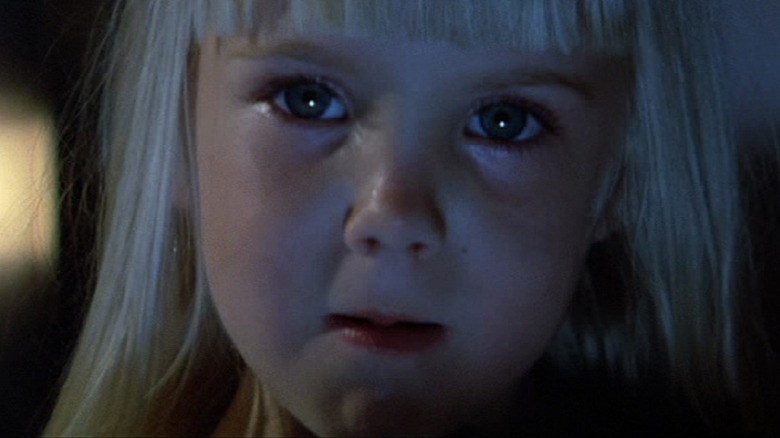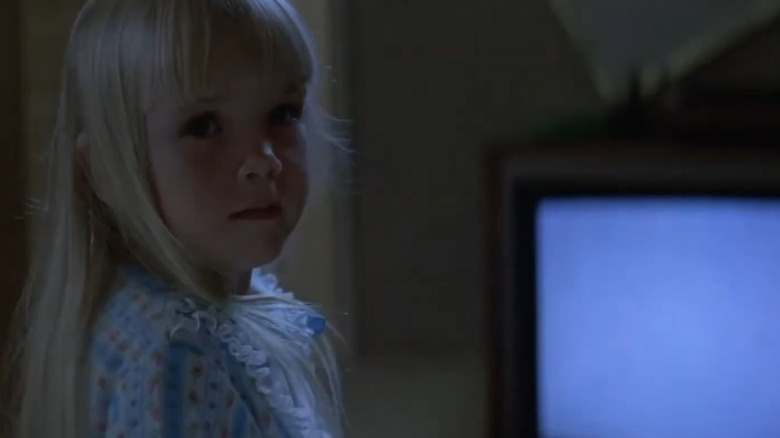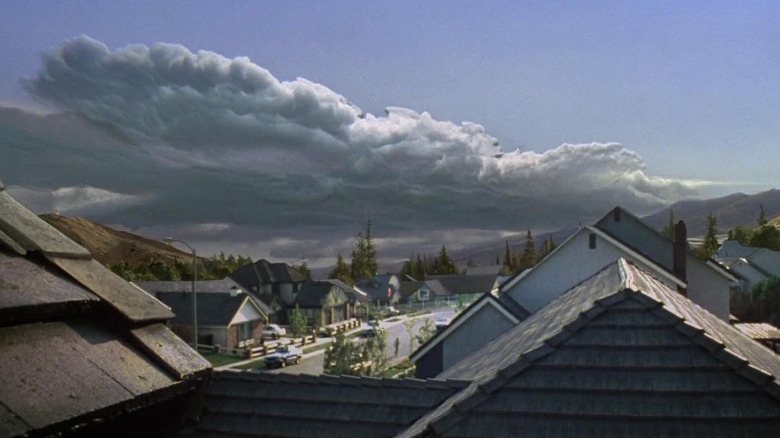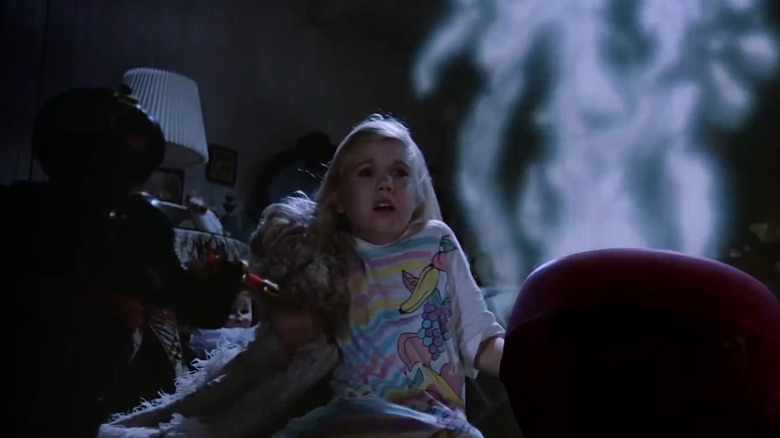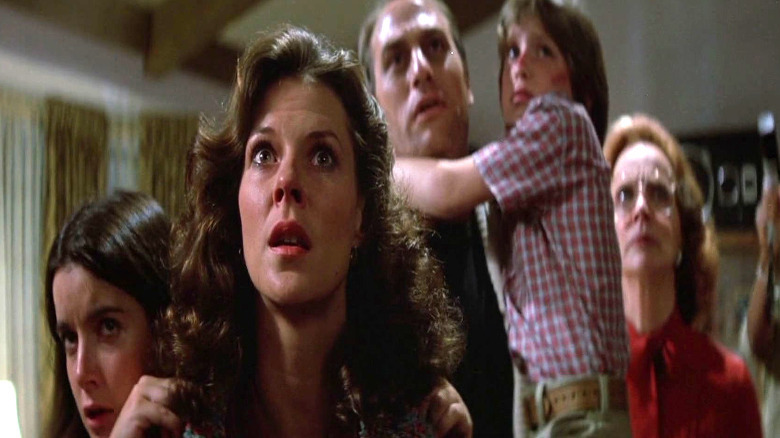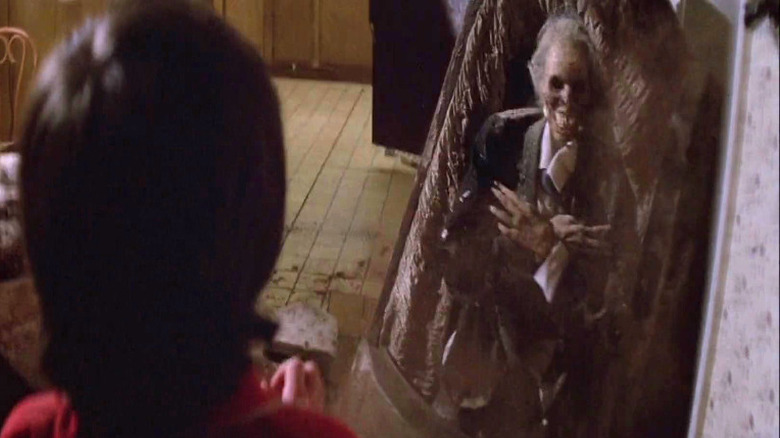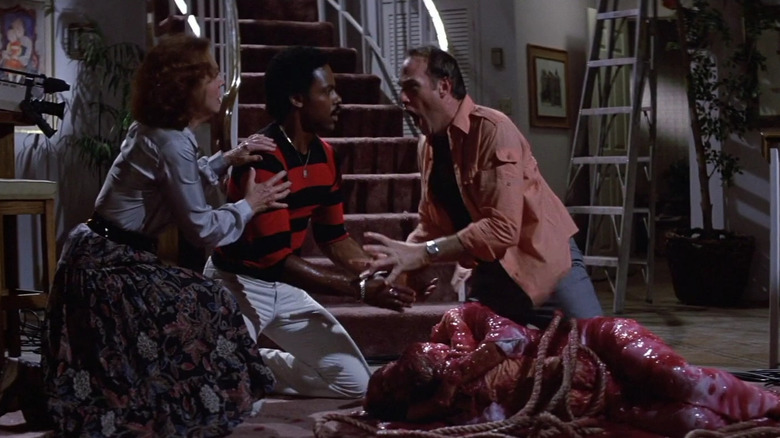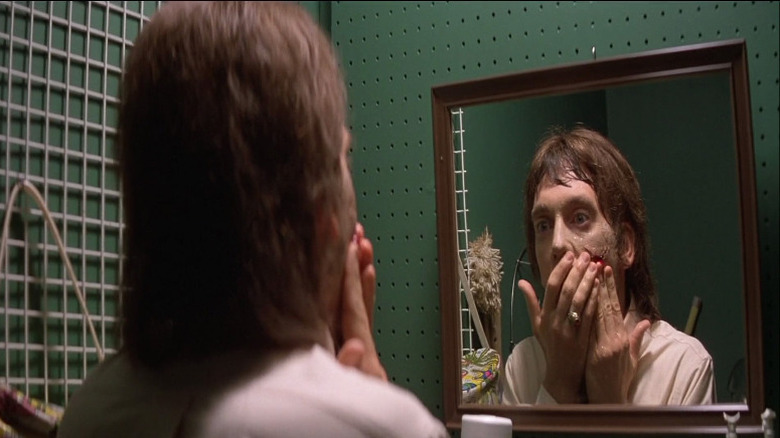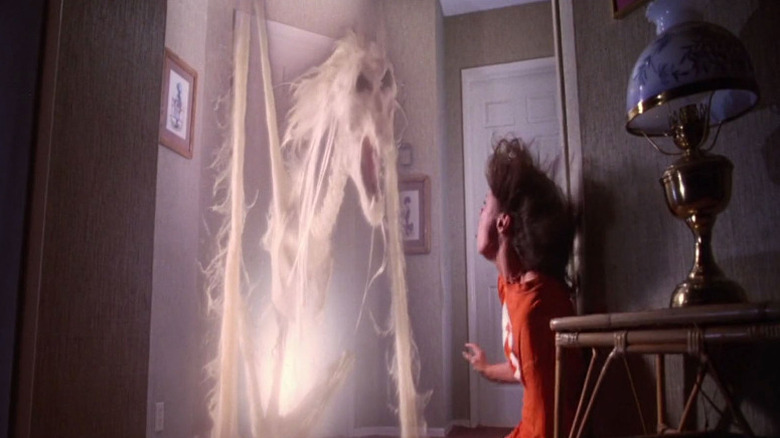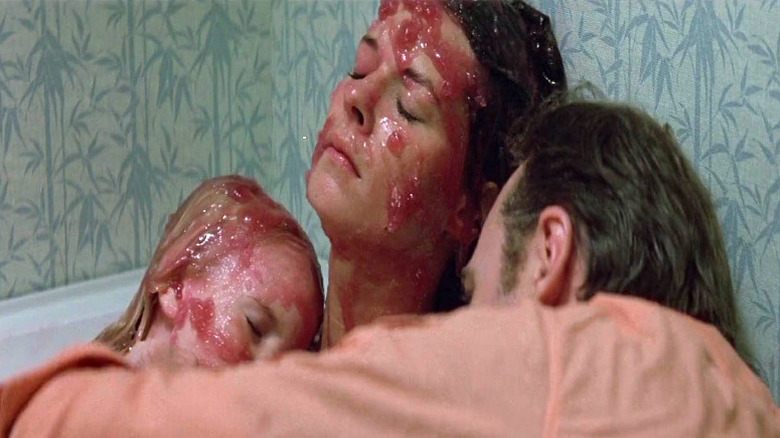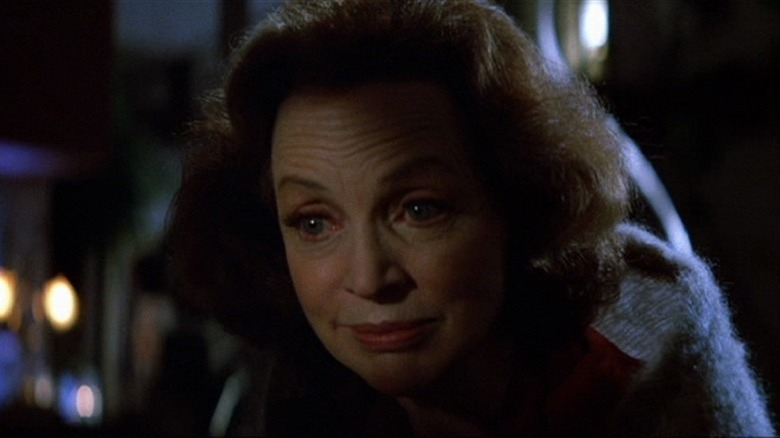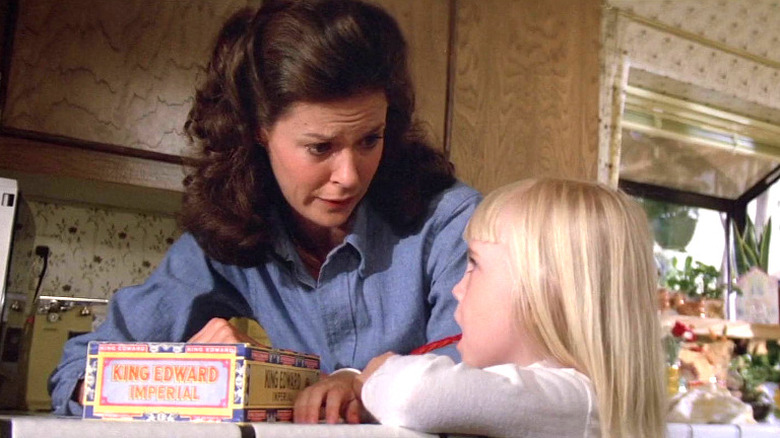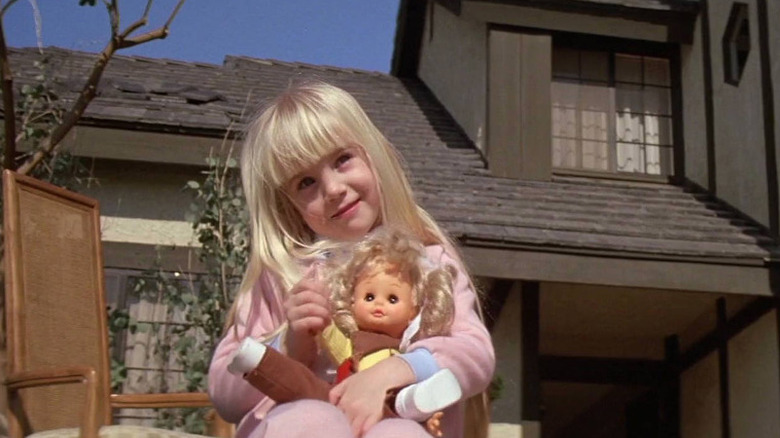Things That Happen In Every Poltergeist Movie
Released in 1982, "Poltergeist" is one of those legendary scary movies that's so iconic it's easy forget just how good it is. A story about a family battling the supernatural in their recently built suburban home, it pushed the boundary of what a haunted house movie could be, terrifying audiences with its creepy clown doll, pool full of skeletons, and dimensional portals opening inside closets.
The Tobe Hooper original also kicked off an entire series, with 1986's "Poltergeist II: The Other Side" and 1988's "Poltergeist III." The films continued to tell the tale of poor Carol Anne Freeling (Heather O'Rourke) and her family's battle against the paranormal — now personified by Julian Beck's cult leader Henry Kane (one of the most terrifying yet underrated '80s horror movie villains). While not as good as the first film, the sequels brought their own identifiable plot points and visuals to the franchise. However, there are plenty of elements that carry over to each film. With the exception of the 2015 remake (because it's supposed to repeat things), we're going to break down and discuss all the things that happen in every "Poltergeist" movie.
They're here
"They're here" is probably the single most iconic line in the entirety of the "Poltergeist" trilogy. There's something so ominous about it. Before Carol Anne says it in the first film, a ghostly hand emerges from the television. Then, spectral lights shoot into the wall above Steven and Diane Freeling's (Craig T. Nelson and JoBeth Williams) bed, and the house quakes. Once the chaos settles, Carol Anne turns to her parents and speaks the immortal words.
This line was popular that it was reworked for the next two films. In "Poltergeist II: The Other Side," Carol Anne answers a toy telephone thinking it's her deceased grandmother. However, it's something far worse. Everything goes crazy with light and smoke and toys moving on their own. Steven and Diane fight their way into the room, and then everything settles. Carol Anne removes the blanket she's been hiding under, turns to her mom and dad and says, "They're back."
In "Poltergeist III," Carol Anne approaches the wall-sized mirror in her bedroom because something isn't right with the reflection. She touches the glass, and fingers reach out, holding her hands in place. Her face in the mirror becomes old and slightly demonic, and the voice of Henry Kane says, "We're back." However, while the sequels found new ways of calling back to the line, it was never as creepy and perfect as the first time.
Strange weather
The nature of the hauntings in "Poltergeist" doesn't always make sense. It's clear that the beings on the other side want to capture and keep Carol Anne, but how they go about it is bizarre. But one aspect of the paranormal activity that remains fairly consistent through the three films is the weather. The first film especially is swarming with storm clouds that signal the terror about to unfold.
In "Poltergeist II," it's shown that Kane is able to manipulate the weather somehow. During one of the more uniquely scary scenes in the movie, Kane approaches the house where the Freelings are staying on a bright, sunny day. The minute he arrives on the street, singing his creepy song, rain falls out of a clear blue sky. Later, the Native American warrior character Taylor (Will Sampson) explains that Kane was testing Freeling patriarch Steven and his strength.
The third film takes place in a Chicago skyscraper with mirrors all over the place and a malfunctioning thermostat. This results in entire floors being covered in ice and snow. It's shown that when characters leave the area of Kane's influence, they immediately feel warm, suggesting he's not only messing with the technology but controlling the atmosphere itself. The final shot of the film is of the skyscraper with a single bolt of lightning striking the ground nearby. Perhaps Kane isn't finished yet.
Malfunctioning technology
The connection between the spirit realm and technology is much clearer in the original "Poltergeist" than in any of the sequels. The first time Carol Anne shows any signs of psychic ability, she's speaking to a television showing only static. She continues to stare at a small TV in the kitchen as well. Then, of course, the "they're here" scene features spirits emerging from the TV. Carol Anne even refers to the ghosts as "the TV people."
Once the haunting really pops off, the technology goes haywire because the ghosts are in control. This isn't as present in "The Other Dimension," but it's still there. For instance, the toys seemingly come to life, and a chainsaw attacks the Freelings as they try to flee in the car. Not only is the technology in "Poltergeist III" on the fritz (elevators malfunctioning, inconsistent temperature), but so is everything else. Kane's influence on the building is so absolute that no one can believe what they see. If there's one thing these movies try to teach us about battling the supernatural it's that technology will not help us. Instead, it may actively work against us.
Desperately seeking Carol Anne
Carol Anne is the key to the "Poltergeist" saga. She's what Kane and his followers are hoping to hold onto to keep them alive in the other dimension (their status as "living" beings is pretty muddled), and of course, she's the youngest member of the Freeling family, so the family wants her back. As a result, every movie is about someone trying to get Carol Anne.
In the first film, she's taken by the end of act one, and the movie then becomes about rescuing the kid from the spirit realm. The second film is the reverse, as Kane is trying to get her back with him so he can use her life force to attract more followers. This means the Freelings are spending the entire movie keeping Carol Anne away from the entities that wish to trap her. However, in the climax of the film, she does fall into the titular "other side," and the entire family has to enter this realm to get her back.
"Poltergeist III" is sort of a blend between the first two. Kane is looking for Carol Anne again, but this time he gets her. Then her cousin Donna (Lara Flynn Boyle), aunt Patricia (Nancy Allen), and uncle Bruce (Tom Skerritt) spend the rest of the movie trying to bring her back safely.
Skeleton invasion
The big secret in the first "Poltergeist" film is that the Freeling house is built over a graveyard. Steven's boss tells him they relocated the cemetery before construction commenced, but this was a lie. As a result, the ending of the film is absolute madness as all hell breaks loose. Monsters cross over from the other side, Robbie (Oliver Robbins) gets attacked by his clown doll, and skeletons just start rocketing out of the ground.
It's here that Steven realizes the truth — the company he works for left the bodies and only moved the headstones! In "Poltergeist II," we learn that the cemetery was the least of the problems. Deep below the graveyard, there's a cavern where a cult locked themselves away to die. In the finale of the film, the Freelings travel into this cavern and discover all of the skeletons of the poor believers who gave up their lives for nothing.
People just randomly turn into skeletons in "Poltergeist III." One unbearable character, Dr. Seaton (Richard Fire), falls to his death in an elevator shaft. The next time we see his dead body on top of the elevator, he's already decomposed into bones. The same is true for Tangina (the excellent Zelda Rubinstein), who's killed by Kane's touch. She instantly becomes emaciated and falls to the floor as withered flesh on bone.
Slime time
Experts in the paranormal will likely tell you that all the slime in these movies is actually ectoplasm or something, but to us, it just looks like slime. In the original film, when Diane and Carol Anne return from the other side, they fall to the ceiling and land on the floor caked in thick gunk. It's never explicitly stated what the stuff is (the movie doesn't explain a lot of the phenomena, really), but it's clearly some kind of fluid that exists between our world and the next.
There isn't a ton of slimy stuff in the sequels, but there are a few instances. One of the real stand-out scenes in "Poltergeist II" is Steven swallowing the worm in a bottle of tequila. The creature opens its eye before entering his body and possesses him. He creepily walks around the house singing Kane's song and making everyone feel uncomfortable before vomiting it up.
Instead of a worm, though, it's now a big blob of flesh that evolves into a grinning monster — with a slick, slimy membrane — that scuttles across the floor. In the third film, Donna returns from the other side (but it isn't really her) by crawling through the corpse of Tangina. Once she emerges, her skin has a thin layer of nasty goo all over it. This is all an example of how the franchise occasionally steps out of the paranormal and into the realm of body horror.
Mirrors are scary
There is a scene in the first "Poltergeist" film that is so upsetting it's shocking they even put it in the movie. After Carol Anne is taken away, the Freelings reach out to a team of paranormal investigators. One of them, a guy named Marty (Martin Casella) who really likes to eat, takes a trip to the bathroom in the middle of the night (after raiding the fridge). That's when he sees his reflection in the mirror ... and proceeds to tear his own face off.
The moment is entirely unexpected, gory, and disturbing. The effects are dated now (the face is clearly animatronic), but the shock is still very real. And while perhaps they're not quite as upsetting, the sequels keep this mirror trend going. In "The Other Side," three ghosts can be glimpsed in the mirror for one shot. It's cool and creepy, but it's "Poltergeist III" that really enjoys messing around with mirrors.
In fact, you could say "Poltergeist III" is all about mirrors. Perhaps commenting on the vanity of America in the 1980s, the skyscraper where the majority of the action takes place has mirrors in every room and hallway. As a result, there are plenty of spooky moments, but one of the best is actually pretty inventive. While Donna does her makeup in the bathroom, we see the door open via her mirror, and Carol Anne peeks in to tell her how great she looks. Donna turns and sees the door is actually still closed. She opens it and finds Carol Anne on the other side, saying the same exact dialogue.
Monster mash
The "Poltergeist" trilogy doesn't only feature eerie close encounters with the dead but unexplainable beings right out of H. P. Lovecraft. The ending of "Poltergeist" is an absolute mad house of otherworldly creatures. There's the horrifying spindly dog creature blocking Diane from her children's bedroom, the monstrous portal in the closet, and a tentacle reaching from beyond to grab Carol Anne.
The second film has a demonic worm that serves as some kind of physical manifestation of Kane. The thing is absolutely hideous and looks like it belongs in a David Cronenberg film. Unfortunately, "Poltergeist III" isn't as interested in creatures — except for one instance in the parking garage, where a puddle serves as a portal. Donna, Carol Anne, and Scott (Kipley Wentz) are pulled into the other world by a humanoid seemingly covered in scar tissue. We don't get a very good look at it, and it's probably just Kane, but the otherworldly glimpse we get suggests it may be another one of the terrifying entities existing in the space between spaces.
Bathing is important
A bathroom is a place where many of us are very vulnerable. They are claustrophobic spaces typically designed to be utilized by one person at a time. Therefore, if someone who wanted to do you harm were to force their way in, it would be very difficult for you to escape. Therefore, it makes perfect sense that horror movies would exploit that. Just think of the iconic shower scene in "Psycho."
"Poltergeist," on the other hand, doesn't always use bathrooms to scare you. They're often used as intended — to bathe. Carol Anne and Diane (covered in slime) are carried upstairs and dropped in the bathtub to wash off and breathe. In "Poltergeist III," Donna comes back from the other side and is set down in the tub, with the shower running to clean her off.
However, at the end of the first film, Diane also takes a bath to relax. "Poltergeist II" has it both ways. On the scary side, we see the ghosts in the mirror, a possessed Steven tries to force himself on Donna, and Robbie is attacked by his own braces (it's a weird movie). There's also a scene where Diane and Carol Anne take a bath together while discussing "Alice in Wonderland." While there's nothing special about people using the bathroom, it is unique to see that all three films have at least one memorable scene set there.
Hushed conversation
Another curious occurrence in each film is the hushed conversation. In the first movie, there's a long scene where Diane and Robbie have a conversation on the nature of death and the afterlife with Dr. Lesh (Beatrice Straight). Something similar happens when Tangina shows up later in the film. The purpose of the scene is to explain the films rules about death in order to answer the audience's questions. The fact that it's whispered makes it feel more honest and intimate than your typical exposition scene.
Almost the same exact scene happens in "Poltergeist II" when Taylor explains what's going on with Kane. This is another attempt to clear up any lingering questions the viewers may have about what's going on and what the stakes are. It doesn't feel as natural the second time around, however. In the third movie, the hushed conversation is just Bruce and Patricia discussing Carol Anne and what's happened between the second and third installments.
A lot of movies do this, but it's usually done when characters are planning something or trying to go unnoticed by some outside party. "Poltergeist" is a unique case where the scenes are utilized to make exposition a little less boring.
Carol Anne has terrible timing
Carol Anne always walks into a room at the most inopportune times. During the first few minutes of "Poltergeist," Diane discovers that their pet canary has died — a bad omen if ever there was one. In secret, she makes her way to the bathroom and dangles the bird above the toilet. Just then, Carol Anne walks in and is shocked to see her beloved pet is no more (a few scenes later she excitedly asks for a goldfish).
"Poltergeist II" sees the Freelings living with Diane's mother. Their financial situation has completely changed, and they have few prospects for the future. We then witness a truly honest scene between two people trying to make light of the nightmare they're in. In the middle of this real moment, Carol Anne opens the door, holding a dress and asking to be a ballerina.
The third movie has a scene where Donna is on the phone with a friend. She explains that Patricia is only her stepmom, so Carol Anne (whom she has to babysit, keeping Donna from a party) isn't really her cousin. Of course, this is exactly when Carol Anne enters the room. The years have matured Carol Anne, though. She doesn't mind Donna saying she isn't her real cousin. In fact, she tells her to go ahead and go to the party because she isn't scared. Of course, this is a huge mistake.
The power of love
From the very beginning, the "Poltergeist" movies have been about love. Obviously, there's the love of a family trying to protect a little girl from evil. However, there's also the idea that the beings lost on the other side need love as well. Kane wants to use Carol Anne's incredible life force, but the rest of his flock have been misled. Only someone in desperate need of love could be convinced that salvation is located in a cavern deep below ground.
The bizarre ending to "Poltergeist II" shows the lengths a family will go to in order to protect each other, including assistance from the deceased Gramma Jess (Geraldine Fitzgerald) in angel form. The third movie, though, makes this messaging explicit. Tangina tells Patricia and Bruce that only love can protect Carol Anne and keep her away from Kane. It all comes down to Patricia, who's struggled to feel something other than apathy for her niece.
In the final moments, though, she does realize she loves Carol Anne, and she always has. Only then do her husband, stepdaughter, and niece return to her. That's the thing about ghost stories — they remind us that love transcends death.
